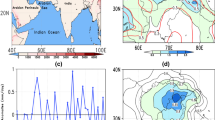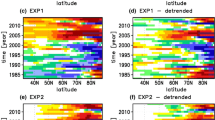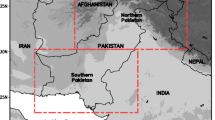Abstract
The present study evaluates the potential predictability, and prediction skill of surface air temperature (SAT) over the Arabian peninsula (AP) referred to as AP-SAT hereafter, during boreal summer (June–July–August: JJA) from 1982 through 2017. The study was made by considering the single model, and a multimodel ensemble (MME) approach. The seasonal prediction data for JJA SAT initialized at May (Lead-1), and April (Lead-2) observed initial conditions, from six coupled atmosphere–ocean global circulation models included in the North American Multimodel Ensemble, is utilized. The potential predictability (PP) is estimated through the estimation of the signal-to-noise ratio (S/N ratio) and perfect model correlation (PMC), while prediction skill is computed by the temporal anomaly correlation coefficient (TCC). All models show a decrease in potential predictability and prediction skill with an increase in lead time. The CFSv2 and NASA models show higher PP, which indicates a high potential predictive skill for summer AP-SAT in these models. However, both models show quite low values of TCC all over the AP domain, which is an indication of overconfident predictions. The three geophysical fluid dynamics laboratory models show high prediction skill at both leads. An essential finding of the predictive analysis (PMC and TCC) is that the MME does outperform the individual model at both leads for summer AP-SAT. Each model captures the observed relationship between spatially averaged AP-SAT with sea surface temperature (SST) and 200 hPa geopotential height (Z200) during JJA, with varying details. Persistent model biases impact negatively model predictability and skill, and better AP-SAT and SST teleconnection pattern in models lead to higher predictability. Improvements in initial conditions, model physics, and larger ensemble size are necessary elements to enhance the summer AP-SAT potential predictability and skill.














Similar content being viewed by others
References
Abid MA, Kucharski F, Almazroui M, Kang IS (2016) Interannual rainfall variability and ECMWF-Sys4-based predictability over the Arabian peninsula winter monsoon region. Q J R Meteorol Soc 142:233–242. https://doi.org/10.1002/qj.2648
Abid MA, Almazroui M, Kucharski F, O’Brien E, Yousef AE (2018) ENSO relationship to summer rainfall variability and its potential predictability over Arabian peninsula region. NPJ Clim Atmos Sci 1:20171
Abutaleb KAA, Mohammed AHES, Ahmed MHM (2018) Climate change impacts, vulnerabilities and adaption measures for Egypt’s nile delta. Earth Syst Environ 2:183. https://doi.org/10.1007/s41748-018-0047-9
Almazroui M (2012a) Temperature variability over Saudi Arabia during the period 1978–2010 and its association with global climate indices. JKAU: Meteoro. Environ Arid Land Agric Sci 23:85–108. https://doi.org/10.4197/Met.23-1.6
Almazroui M (2012b) Temperature variability over Saudi Arabia during the period 1978–2010 and its association with global climate indices. JKAU Meteorol Environ Arid Land Agric Sci 1:1. https://doi.org/10.4197/met.23-1.6
Almazroui M, Islam MN, Athar H, Jones PD, Rahman MA (2012a) Recent climate change in the Arabian peninsula: annual rainfall and temperature analysis of Saudi Arabia for 1978–2009. Int J Climatol 32:953–966
Almazroui M, Islam MN, Jones PD, Athar H, Rahman MA (2012b) Recent climate change in the Arabian peninsula: seasonal rainfall and temperature climatology of Saudi Arabia for 1979–2009. Atmos Res 111:29–45
Almazroui M, Islam MN, Dambul R, Jones PD (2014) Trends of temperature extremes in Saudi Arabia. Int J Climatol 34:808–826
Almazroui M et al (2017) Saudi-KAU coupled global climate model: description and performance. Earth Syst Environ 1:7. https://doi.org/10.1007/s41748-017-0009-7
Attada R, Dasari HP, Chowdary JS, Yadav RK, Knio O, Hoteit I (2018a) Surface air temperature variability over the Arabian peninsula and its links to circulation patterns. Int J Climatol 39:445–464. https://doi.org/10.1002/joc.5821
Attada R, Yadav RK, Kunchala RK, Dasari HP, Knio O, Hoteit I (2018b) Prominent mode of summer surface air temperature variability and associated circulation anomalies over the Arabian peninsula. Atmos Sci Lett 1:1. https://doi.org/10.1002/asl.860
Bonan GB (2008) Forests and climate change: forcings, feedbacks, and the climate benefits of forests. Science 320:1444–1449
Chandran A, Basha G, Ouarda TBMJ (2015) Influence of climate oscillations on temperature and precipitation over the United Arab Emirates. Int J Climatol 36:225–235
Chen S, Wu R (2017) Interdecadal changes in the relationship between interannual variations of spring North Atlantic SST and Eurasian surface air temperature. J Clim 30:3771–3787
Chen W, Hong X, Lu R, Jin A, Jin S, Nam J, Shin J, Goo T, Kim B (2016) Variation in summer surface air temperature over northeast Asia and its associated circulation anomalies. Adv Atmos Sci 33:1–9. https://doi.org/10.1007/s00376-015-5056-0
Chooprateep S, McNeil N (2016) Surface air temperature changes from 1909 to 2008 in Southeast Asia assessed by factor analysis. Theor Appl Climatol 123:361–368
Coumou D, Capua GD, Vavrus S, Wang L, Wang S (2018) The influence of Arctic amplification on mid-latitude summer circulation. Nat Commun 9:2959
De Vries AJ, Tyrlis E, Edry D, Krichak S, Steil B, Lelieveld J (2013) Extreme precipitation events in the Middle East: dynamics of the active Red Sea trough. J Geophys Res Atmos 118:7087–7108. https://doi.org/10.1002/jgrd.50569
De Vries AJ, Ouwersloot HG, Feldstein S, Riemer M, Kenawy AE, McCabe M, Lelieveld J (2018) Identification of tropica-lextratropical interactions and extreme precipitation events in the Middle East based on potential vorticity and moisture transport. J Geophys Res Atmos 123:861–881. https://doi.org/10.1002/2017JD027587
DelSole T, Tippett MK (2014) Comparing forecast skill. Mon Weather Rev 142:4658–4678. https://doi.org/10.1175/MWR-D-14-00045.1
DelSole T, Nattala J, Tippett MK (2014) Skill improvement from increased ensemble size and model diversity. Geophys Res Lett 41:7331–7342. https://doi.org/10.1002/2014GL060133
DelSole T, Trenary L, Tippett MK, Pegion K (2017) Predictability of week-3–4 average temperature and precipitation over the contiguous United States. J Clim 30:3499–3512
Delworth et al (2006) GFDL’s CM2 global coupled climate models. Part I: formulation and simulation characteristics. J Clim 19:643
Donat MG et al (2014) Changes in extreme temperature and precipitation in the Arab region: long-term trends and variability related to ENSO and NAO. Int J Climatol 34:581–592
Eade R, Smith D, Scaife A, Wallace E, Dunstone N, Hermanson L, Robinson N (2014) Do seasonal-to-decadal climate predictions underestimate the predictability of the real world? Geophys Res Lett 41:5620–5628. https://doi.org/10.1002/2014GL061146
Ehsan MA, Kang IS, Almazroui M, Abid MA, Kucharski F (2013) A quantitative assessment of changes in seasonal potential predictability for the twentieth century. Clim Dyn 41:2697–2709
Ehsan MA, Tippett MK, Almazroui M, Ismail M, Yousef A, Kucharski F, Omar M, Hussein M, Alkhalaf AK (2017a) Skill and predictability in multimodel ensemble forecasts for Northern Hemisphere regions with dominant winter precipitation. Clim Dyn 48:3309–3324
Ehsan MA, Almazroui M, Yousef A, Enda OB, Tippett MK, Kucharski F, Alkhalaf AK (2017b) Sensitivity of AGCM simulated regional summer precipitation to different convective parameterizations. Int J Climatol 37:4594–4609
Evan AT, Flamant C, Lavaysse C, Kocha C, Saci A (2015) Water vapor–forced greenhouse warming over the Sahara Desert and the recent recovery from the Sahelian drought. J Clim 28:108–123. https://doi.org/10.1175/JCLI-D-14-00039.1
Faller AJ (1981) An average correlation coefficient. J Appl Meteorol 20:203–205
Fan Y, Dool HVD (2008) A global monthly land surface air temperature analysis for 1948-present. J Geophys Res 113:D01103. https://doi.org/10.1029/2007JD008470
Gent et al (2011) The community climate system model version 4. J Clim 24:4973–4991
Hagedorn R, Doblas-Reyes FJ, Palmer TN (2005) The rationale behind the success of multi-model ensembles in seasonal forecasting. Part I: basic concept. Tellus A 57:219–233
Hasanean HM, Almazroui M (2017) Teleconnections of the tropical sea surface temperatures to the surface air temperature over Saudi Arabia in summer season. Int J Climatol 37:1040–1049
Jia L, Yang X, Vecchi GA, Gudgel RG, Delworth TL, Rosati A, Stern WF, Wittenberg AT, Krishnamurthy L, Zhang S, Msadek R, Kapnick S, Underwood S, Zeng F, Anderson WG, Balaji V, Dixon K (2015) Improved seasonal prediction of temperature and precipitation over land in a high-resolution GFDL climate model. J Clim 28:2044–2062
Kanamitsu M et al (2002) NCEP-DEO AMIP-II reanalysis (R-2). Bull Am Meter Soc 83:1631–1643
Kang IS, Shukla J (2006) The Asian monsoon. In: Dynamic Seasonal Prediction and Predictability of the Monsoon. Springer, Chichester
Kang IS, Yoo JH (2006) Examination of multi-model ensemble seasonal prediction methods using a simple climate system. Clim Dyn 26:285–294. https://doi.org/10.1007/s00382-005-0074-8
Kirtman BP et al (2014) The North American multimodel ensemble: phase-1 seasonal-to-interannual prediction; phase-2 toward developing intraseasonal prediction. Bull Am Meteorol Soc 95:585–601
Lelieveld J, Hadjinicolaou P, Kostopoulou E, Chenoweth J, Giannakopoulos C, Hannides C, Lange MA, El Maayar M, Tanarthe M, Tyrlis E, Xoplaki E (2012) Climate change and impacts in the eastern Mediterranean and the Middle East. Clim Change 114:667–687
Li JP, Sun C, Jin FF (2013) NAO implicated as a predictor of Northern Hemisphere mean temperature multidecadal variability. Geophys Res Lett 40:5497–5502
Miralles DG, Teuling AJ, Van Heerwaarden CC (2014) Mega-heatwave temperatures due to combined soil desiccation and atmospheric heat accumulation. Nat Geosci 7:345–349. https://doi.org/10.1038/ngeo2141
Mustafa A, Rahman G (2018) Assessing the spatio-temporal variability of meteorological drought in Jordan. Earth Syst Environ 2:247–264. https://doi.org/10.1007/s41748-018-0071-9
Osman M, Vera CS (2017) Climate predictability and prediction skill on seasonal time scales over South America from CHFP models. Clim Dyn 49:2365–2383
Pal JS, Eltahir EAB (2015) Future temperatures in southwest Asia projected to exceed a threshold for human adaptability. Nat Clim Change 6:197–200
Palmer TN et al (2004) Development of a European multimodel ensemble system for seasonal-to-interannual prediction (DEMETER). Bull Amer Meteor Soc 85:853–872
Rahman MA, Almazroui M, Islam MN, Brien EO, Yousef AE (2018) The role of land surface fluxes in Saudi-KAU AGCM: temperature climatology over the Arabian peninsula for the period 1981–2010. Atmos Res 200:139–152
Rayner NA, Parker DE, Horton EB, Folland CK, Alexander LV, Rowell DP, Kent EC, Kaplan A (2003) Global analyses of sea surface temperature, sea ice, and night marine air temperature since the late nineteenth century. J Geophys Res 108:4407
Rodwell MJ, Hoskins BJ (1996) Monsoons and the dynamics of deserts. Q J Roy Meteorol Soc 122:1385–1404
Ropelewski CF, Halpert MS (1986) North American precipitation and temperature patterns associated with the El Nino-Southern Oscillation (ENSO). Mon Weather Rev 114:2352–2362
Ropelewski CF, Halpert MS (1987) Global and regional scale precipitation patterns associated with the El Nino/Southern Oscillation. Mon Weather Rev 115:1606–1626
Rowell DP (1998) Assessing potential seasonal predictability with an ensemble of multidecadal GCM simulations. J Clim 11:109–120
Rowell DP, Folland CK, Maskell K, Ward MN (1995) Variability of summer rainfall over tropical North Africa (190692): observations and modeling. Q J R Meteorol Soc 121:669–704
Saha S et al (2014) The NCEP climate forecast system version 2. J Clim 27:2185–2208
Sun C, Li JP, Ding RQ, Jin Z (2017) Cold season Africa-Asia multidecadal teleconnection pattern and its relation to the Atlantic multidecadal variability. Clim Dyn 48:3903–3918. https://doi.org/10.1007/s00382-016-3309-y
Tang Y, Chen D, Yan X (2014a) Potential predictability of Northern America surface temperature part I: information-based vs signal-to-noise based metrics. J Clim 27:1578–1599
Tang Y, Chen D, Yan X (2014b) Potential predictability of Northern America surface temperature in AGCMs and CGCMs. Clim Dyn 45:353–374
Taylor KE (2001) Summarizing multiple aspects of model performance in a single diagram. J Geophys Res 106:7183–7192
Tippett MK, Almazroui M, Kang IS (2015) Extended-range forecasts of areal-averaged Saudi Arabia rainfall. Weather Forecast 30:1090–1105. https://doi.org/10.1175/WAF-D-15-0011.1
Vecchi GA et al (2014) On the seasonal forecasting of regional tropical cyclone activity. J Clim 27:7994–8016
Vernieres G, Keppenne C, Rienecker MM, Jacob J, Kovach R (2012) The GEOS-ODAS, description and evaluation. NASA Technical report series on global modeling and data assimilation, NASA/TM 30:104606. National Aeronautics and Space Administration, Goddard Space Flight Center, Greenbelt, Maryland
Vigaud N, Tippett MK, Robertson AW (2018) Probabilistic skill of subseasonal precipitation forecasts for the East Africa-west Asia sector during September to May. Weather Forecast 33:1513–1532. https://doi.org/10.1175/WAF-D-18-0074.1
Wilks DS (2006) Statistical methods in the atmospheric sciences (Chapter no. 5), 2nd edn. Elsevier, New York
Acknowledgements
We are grateful to the three anonymous reviewers whose comments significantly improved the quality of the manuscript. We acknowledge NOAA MAPP, NSF, NASA, and the DOE that support the NMME-Phase II system, and we thank the climate modeling groups (Environment Canada, NASA, NCAR, NOAA/GFDL, NOAA/NCEP, and University of Miami) for producing and making available their model output. NOAA/NCEP, NOAA/CTB, and NOAA/CPO jointly provided coordinating support and led the development of the NMME-Phase II system. We also acknowledge King Abdulaziz University’s High-Performance Computing Center (Aziz Supercomputer: http://hpc.kau.edu.sa) for providing computation support for this work.
Author information
Authors and Affiliations
Corresponding author
Additional information
Publisher's Note
Springer Nature remains neutral with regard to jurisdictional claims in published maps and institutional affiliations.
Electronic supplementary material
Below is the link to the electronic supplementary material.
Rights and permissions
About this article
Cite this article
Ehsan, M.A., Kucharski, F., Almazroui, M. et al. Potential predictability of Arabian peninsula summer surface air temperature in the North American multimodel ensemble. Clim Dyn 53, 4249–4266 (2019). https://doi.org/10.1007/s00382-019-04784-3
Received:
Accepted:
Published:
Issue Date:
DOI: https://doi.org/10.1007/s00382-019-04784-3




